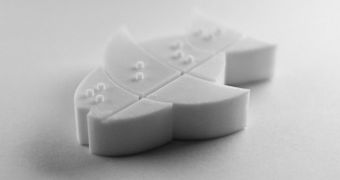The concept behind Braille is a little like Morse code, with small dots or sets of dots interposed at varying intervals, for people to touch and “read.” “Fittle,” a new 3D printing application, will help the visually impaired learn the language.
Obviously, the blind or partially blind can't read normal books, or computer programs. Braille was invented for them, as an alternative.
Now, the Fittle 3D printing application came as a result of Indian post graduate student Tania Jain’s conclusions on the matter of the language and the visually impaired.
Not only is the physical medium perfect for them, but those who know the Braille alphabet do better in school.
In fact, nearly or completely blind students who use Braille often do better than partially blind ones who do not use the language.
It doesn't hurt that reading Braille is quick and in no way tiresome, and that there is plenty of reading material rendered in that format.
So what does Fittle do? It uses FDM/FFF 3D printers to create small figurines and slabs of plastic that make it easier to learn Braille.
A fish-shaped figure can have the Braille for “fish” on it, for example. It's a great learning aide for those who want some measure of independence and self-reliance.
In fact, Fittle (a mish-mash of “fit the puzzle”) intends for learners to put together figures on their own. To match the pieces together through their physical connections (each piece has an outer border and a 3D puzzle-like hole and protuberance), thus forming an entire word.
The term can then be associated to the shape they have just composed. So you can feel what a fish or animal looks like. This way, children can actually imagine what animals and objects look like. Fittle comes with an app that lets educators and parents work together with their children.

 14 DAY TRIAL //
14 DAY TRIAL //